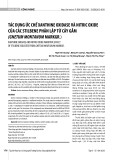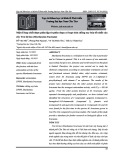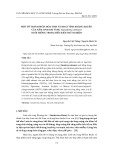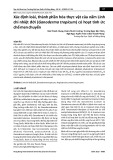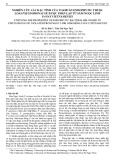
Tập 18 Số 3-2024, Tạp chí Khoa học Tây Nguyên
1
APPLYING BIOINFORMATICS TO ANALYZE AUXIN-RELATED GENES IN
ROBUSTA COFFEE GENOME (Coffea canephora L.)
Nguyen Dinh Sy1
Received Date: 14/06/2024; Revised Date: 26/06/2024; Accepted for Publication: 27/06/2024
ABSTRACT
Coffea canephora, which belongs to the Rubiaceae family, is one of the most popular cultivated
coffea worldwide. In this study, we identified and analyzed candidate genes that involved in auxin-
related gens in the C. canephora genome. The results showed that genome of C. canephora consists of
152 protein-coding genes related to auxin which are divided into 7 main groups depending on domain
and motif: Auxin-induced protein; Auxin-binding protein; Auxin transporter-like protein; Auxin carrier
component; Auxin response factor; Auxin-responsive protein; Auxin signaling protein. Using SMART
software to analyze protein structure, the result indicated that there are some characteristic domains
involved in auxin response such as EamA; AUX_IAA; Auxin inducible; Aldo_ket_red; Cupin; Aa_
trans; B3, Auxin_resp; Mem_trans; B561; GH3; and LRR domain. The study on candidate protein-
coding genes relating to auxin is important for elucidating protein functions involved in various cellular
processes, growth, development and climate change adaptation of C. canephora.
Keywords: Auxin, bioinformatic, C. canephora, domain protein, genome.
1. INTRODUCTION
Although the Coffea genus includes more
than 124 species, C. canephora (2n=2x=22)
and C. arabica (2n=4x=44) are the most coffee
bean productions with 40% and 60% in total
production worldwide, respectively. FAS (2024)
estimated that global coffee production in the
2024/2025 crop year will increase by 4.2%
compared to the previous crop to 176 million
bags, of which arabica production will increase
by 4.4% to 99.86 million bags and robusta will
increase by 3.9% to 76.38 million bags. Vietnam
is the world’s largest robusta coffee producer
with export turnover in 2023 reaching 4.2 billion
US Dollars.
Recently, several articles were published about
genome sequencing (Pallavicini et al., 2005; Vieira
et al., 2006; Denoeud et al., 2014 abiotic response
genes (Nguyen Dinh et al., 2016; Dinh and Kang,
2017), genes for tolerance to disease (Barbosa
et al., 2010; Albuquerque et al., 2015; Vadivelu,
2013) or caffeine biosynthetic pathway (Perrois et
al., 2015).
C. canephora genome sequence was
published on Coffee Genome Hub (http://coffee-
genome.org). Data available are the complete
genome sequence of C. canephora along with
gene structure, gene product information,
metabolism, gene families, transcriptomics
(ESTs, RNA-Seq), genetic markers and genetic
maps. The hub provides also tools for easy
querying, visualizing and downloading research
data (Denoeud et al., 2014).
Diseases, pests and abiotic stresses are
detrimental not only reducing yield and coffee
quality, but also harmful for the economic and
livelihood of coffee farmers who depend on
it. Some research focused on several genes for
tolerance and resistance. CaWRKY1 gene in
C. arabica is a positive control against Rust
fungus Hemileia vastatrix. α-amylase inhibitor-1
gene (α-AI1) was able to protect from coffee
berry borer insect-pest by Hypotheneumus
hampei for coffee plants (Barbosa et al., 2010;
Albuquerque et al., 2015). CaNPR1 gene plays
an important role in resistance against coffee leaf
rust caused by H. growatrix in C. arabica and
other plants (Vadivelu, 2013). Metallothionine
gene expression studies, including CaMT4,
CaMT15, CaMT3 and CaMT8 was elucidated
the role of metallothionine in maintaining Cu
and Zn homeostasis and in detoxifying these
excess nutrients (Bulgarelli et al., 2016). The
full-length C. arabica Protein Domain (CaBDP)
gene sequence was extracted from the RNA of
drought-tolerant C. arabica leaves. Genes have
been cloned in Arabidopsis to characterize plant
drought and salt tolerance (Nguyen Dinh et al.,
2016; Dinh and Kang, 2017). Nguyen Dinh Sy
et al., 2022 overview C. canephora L. genome
and its function in stress response and caffeine
biosynthesis, and analyzed candidate genes for
dehydration stress response in C. canephora L.
1Faculty of Natural Science and Technology, Tay Nguyen University;
Corresponding author: Nguyen Dinh Sy; Tel: 0961367958; Email: ndsy@ttn.edu.vn.

Tập 18 Số 3-2024, Tạp chí Khoa học Tây Nguyên
2
Identification of the genes associated with the
caffeine biosynthetic pathway in coffee provided
the importance tool for regulating the caffeine
biosynthesis to effectively help possibly produce
more caffeine content and caffeine-free coffee
for consumers in the future. Perrois et al., 2015
demonstrated that the differential regulation of
caffeine metabolism depends on the transcriptional
activity that controls the differential expression
of XMT1 and DXMT genes in C. arabica and C.
canephora. Recently, Raharimalala et al., 2021
showed that Coffea humblotiana, a wild species
from Comoro archipelago, which is lacks of
caffeine synthase coding gene involved in the
naturally decaffeinated status. Up to now, the
evolution of NMT genes in C. canephora are
NMT2; DXMT; XMT; MXMT; NMT3; MTL,
which represent the methylation steps of the
caffeine biosynthesis.
There are many genes, activators, and promoter
genes in coffee plants that are continuously being
discovered to elucidate their function, especially in
a growth stimulation. Therefore, this research aims
to screen and analyze auxin- related gene of coffee
genome that select candidate genes for transgenic
coffee plants to stimulate growth of coffee tree.
2. MATERIALS AND METHODS
2.1. Materials
- DNA sequencing genome of C. canephora
that downloaded from website Coffee Genome
Hub (coffee-genome.org/coffeacanephora).
2.2. Methods
- DNA sequencing genome of C. canephora
was downloaded from website Coffee Genome
- To screening genes related to auxin response,
the key words “auxin” was used.
- Using software SMART (http://smart.embl.de)
to analyze protein structure (domain; motif).
3. RESULTS AND DISCUSSION
3.1. Identification and classification of auxin
related genes
From a total of 25,574 genes in C. canephora
genome (Denoeud et al., 2014) screening on
protein-coding gene for auxin showed that there
are total of 152 genes that anchored regularly in
11 chromosomes (chro.). The length of auxin-
related genes is from 165 nucleotides (Cc11_
g04780) to 3342 nucleotides (Cc00_g00210).
Especially, Auxin transport protein BIG (Cc07_
g04520) contains 15.333 nucleotides.
Among 152 protein-coding genes related
to auxin, they are divided into 7 main groups
depending on domain such as Auxin-induced
protein; Auxin-binding protein; Auxin transporter-
like protein; Auxin carrier component; Auxin
response factor; Auxin-responsive protein; auxin
signaling protein (table 1-3).
Table 1. The list of protein-coding-genes related to Auxin-induced protein
Gene No.
a.a Gene No. a.a Gene No. a.a Gene No. a.a
Cc01_g03080 858 Cc02_g16790 106 Cc07_g17560 372 Cc10_g01880 149
Cc01_g04600 331 Cc03_g04660 195 Cc07_g18590 361 Cc10_g02240 361
Cc01_g04610 92 Cc03_g05360 366 Cc07_g18600 378 Cc10_g10920 383
Cc01_g16330 251 Cc03_g08720 66 Cc07_g18610 405 Cc10_g12900 345
Cc01_g18860 97 Cc03_g14930 357 Cc07_g18620 377 Cc10_g14810 371
Cc02_g08320 380 Cc04_g03610 191 Cc07_g19260 190 Cc10_g14820 367
Cc02_g22010 390 Cc04_g06760 210 Cc07_g19990 377 Cc11_g04790 146
Cc02_g22030 412 Cc06_g03030 340 Cc08_g05620 394 Cc11_g04800 104
Cc02_g24230 179 Cc06_g12640 166 Cc08_g08390 156 Cc11_g10080 112
Cc02_g35440 368 Cc06_g14090 380 Cc08_g12360 321 Cc11_g10090 362
Cc02_g16700 99 Cc06_g14100 268 Cc08_g12980 184 Cc11_g14380 369
Cc02_g16710 107 Cc06_g20270 407 Cc08_g17100 112 Cc11_g14390 360
Cc02_g16730 106 Cc07_g02470 341 Cc09_g00760 405 Cc11_g14400 317
Cc02_g16740 103 Cc07_g17000 371 Cc09_g02950 392 Cc00_g13700 315
Cc02_g16750 95 Cc07_g17010 369 Cc09_g08800 376 Cc00_g15180 208
Cc02_g16760 97 Cc07_g17030 315 Cc10_g01860 106

Tập 18 Số 3-2024, Tạp chí Khoa học Tây Nguyên
3
Table 2. The list of protein-coding-genes that related to auxin responsive protein/ Auxin response
factor
Gene No.
a.a Gene No. a.a Gene No. a.a Gene No. a.a
Auxin responsive protein
Cc01_g10550 144 Cc03_g06860 404 Cc06_g04040 277 Cc09_g00710 407
Cc01_g16320 401 Cc03_g09650 399 Cc06_g06020 129 Cc09_g07120 387
Cc01_g17790 326 Cc03_g13450 72 Cc06_g08150 216 Cc09_g10510 104
Cc02_g30730 246 Cc04_g00010 161 Cc06_g10040 338 Cc10_g08190 367
Cc02_g33360 483 Cc04_g02510 362 Cc06_g12650 122 Cc11_g04780 55
Cc02_g39040 189 Cc04_g02890 335 Cc06_g13230 180 Cc11_g09650 196
Cc02_g40000 183 Cc04_g03620 203 Cc07_g07780 375 Cc00_g04150 405
Cc03_g04670 240 Cc05_g14040 410 Cc07_g19210 103 Cc00_g26580 107
Cc03_g06400 266 Cc05_g16250 142 Cc08_g00560 173 Cc00_g29740 101
Auxin response factor
Cc01_g11020 699 Cc02_g23580 222 Cc03_g13510 183 Cc07_g12410 846
Cc01_g11410 832 Cc02_g39520 697 Cc03_g13520 86 Cc08_g16330 694
Cc02_g11300 669 Cc03_g11270 221 Cc05_g00510 895 Cc09_g08740 907
Cc02_g14070 683 Cc03_g12730 216 Cc06_g03950 707 Cc10_g01900 950
Cc02_g23570 434 Cc03_g13500 94 Cc06_g12540 1079 Cc00_g00210 1114
Cc00_g12260 863
Table 3. The list of protein-coding-genes that related to auxin-binding protein/ Auxin carrier
protein/ Auxin transporter-like protein
Gene No.
a.a Gene No. a.a Gene No. a.a Gene No. a.a
Auxin-binding protein
Cc01_g03720 140 Cc01_g05150 201 Cc06_g12080 208 Cc00_g05320 171
Auxin carrier protein
Cc03_g13040 148 Cc07_g03020 360 Cc07_g12290 416 Cc10_g12950 345
Cc04_g06290 603 Cc07_g08300 458 Cc07_g12300 414 Cc10_g14830 363
Cc06_g00150 423 Cc07_g12020 423 Cc09_g03470 358 Cc11_g08680 666
Cc06_g12940 619 Cc07_g12270 411 Cc09_g03480 359 Cc11_g08940 451
Cc06_g19880 600 Cc07_g12280 412 Cc10_g00190 173
Auxin transporter-like protein
Cc02_g06770 475 Cc05_g00830 477 Cc07_g04520 5111
Cc02_g16390 502 Cc06_g01510 486 Cc10_g11120 398
Auxin signaling
Cc02_g13650 126 Cc04_g00930 144 Cc07_g01170 464

Tập 18 Số 3-2024, Tạp chí Khoa học Tây Nguyên
4
3.2. Motif and domain structure
SMART software (http://smart.embl.de) was
applied to analyze domain and motif protein
structure of 7 groups: Auxin-induced protein;
Auxin-binding protein; Auxin transporter-like
protein; Auxin carrier protein; Auxin response
factor; Auxin responsive protein; Auxin signaling
protein.
Group 1: Auxin-induced protein
Auxin-induced protein group contains EamA
domain; or AUX_IAA domain; or Auxin inducible
domain (Figure 1).
Figure 1. EamA, AUX_IAA, Auxin inducible,
and Aldo_ket_red domain structure of Auxin-
induced protein
The EamA domain, named after the O-acetyl-
serine/cysteine export gene in E. coli, can be
found in various proteins. One example is the
PecM protein in Erwinia chrysanthemi regulates
pectinase, cellulase, and blue pigment. Another
example is the PagO protein in Salmonella
typhimurium, although its function is unknown.
Additionally, some members of the solute carrier
family group 35 (SLC35) nucleoside-sugar
transporters also possess this domain. Many
proteins in this family are classified as drug/
metabolite transporters, yet their function remains
unidentified. These proteins are anticipated to be
integral membrane proteins, and it’s worth noting
that many of them contain two copies of the EamA
domain (Jack et al., 2001).
Transcription of the AUX/IAA genes occurs
quickly in response to the plant hormone auxin
(Abel et al., 1995). Certain members of this gene
family are longer and possess a DNA binding
domain at the beginning (like O64965). The
inclusion here signifies the C-terminal portion
of the AUX/IAA proteins. However, the specific
function of this region remains uncertain.
This entry represents a group of plant
proteins that respond to auxin, known as small
auxin-up RNA (SAUR) (Gil and Green, 1997).
The first SAUR gene was initially discovered
in soybean hypocotyls (McClure and Guilfoyle,
1987). SAUR genes are primarily active in
growing hypocotyls or other tissues involved in
elongation. This suggests that they play a role in
regulating cell elongation SAUR proteins might
serve as a connection between auxin and plasma
membrane H+-ATPases (PM H+-ATPases) in
Arabidopsis thaliana (Spartz et al., 2014).
The aldo-keto reductase family consists of
various related enzymes that are monomeric and
depend on NADPH to carry out oxidoreduction
reactions. Some examples of these enzymes
are aldehyde reductase, aldose reductase,
prostaglandin F synthase, xylose reductase, rho
crystallin, and others (Bohren et al, 1989). They
all share a similar structure characterized by a
beta-alpha-beta fold, which is typical of proteins
that bind nucleotides (Schade et al., 1990). This
fold comprises a barrel shape with parallel beta-
strands and alpha helices, containing a unique
motif that binds NADP. The binding site is situated
in a large, deep, elliptical pocket at the C-terminal
end of the beta- sheet, where the substrate binds
in an extended form. The pocket’s hydrophobic
nature means it favors aromatic and non-polar
substrates, rather than highly polar ones (Wilson
et al., 1992). When the NADPH coenzyme binds,
it induces a significant conformational change
that repositions a loop, effectively securing
the coenzyme in place. This binding is more
akin to FAD-binding oxidoreductases than
NAD(P)-binding ones (Borhani et al., 1992). In
some proteins within this category, there is an
additional domain called the K+ ion channel beta
chain regulatory domain, which has been shown
to possess oxidoreductase activity (Gulbis et al.,
2000). This entry represents the domain found in
these proteins responsible for NADP-dependent
oxidoreductase activity.
Group 2: Auxin-binding protein
This family represents the conserved barrel
domain of the ‘cupin’ superfamily (Figure 2).
This family contains 11S and 7S plant seed
storage proteins, and germins. Plant seed storage
proteins provide the major nitrogen source for the
developing plant (Dunwell, 1998).

Tập 18 Số 3-2024, Tạp chí Khoa học Tây Nguyên
5
Figure 2. Cupin domain structure of Auxin-
binding protein
Red: signal peptide.
Group 3: Auxin transporter-like protein
This transmembrane domain is present
in various amino acid transporters, such as
P34579 (UNC-47) and P40501 (MTR). UNC-
47 encodes a vesicular amino butyric acid
(GABA) transporter (VGAT), and it is predicted
to consist of 10 transmembrane domains
(UNC47_CAEEL) (McIntire et al., 1997). MTR
is a protein associated with the N system amino
acid transporter system, which is involved in
methyltryptophan resistance (MTR_NEUCR).
Other proteins possess this domain, including
proline transporters and amino acid transporters
with unidentified specificities.
Figure 3. Aa_trans domain structure of Auxin
transporter-like protein
Pink: low complexity region.
Group 4: Auxin carrier protein
This entry represents a family of membrane
transport proteins that have not been fully
characterized yet. These proteins are found in
eukaryotes, bacteria, and archaea. The most
well-studied members of this family are the PIN
components of auxin efflux systems in plants.
These carriers are specific to auxin, meaning
they only transport auxin molecules, and they
are found at the basal ends of cells that can
transport auxin (Blakeslee et al., 2005; Kramer,
2004).
Figure 4. Mem_trans domain structure of
Auxin carrier protein
Plants usually have multiple proteins from this
family, each with a unique pattern of expression in
specific tissues. They are present in various plant
tissues, including vascular tissues and roots. These
proteins play a role in several processes, such as
establishing embryonic polarity, promoting plant
growth, forming apical hooks in seedlings, and
influencing responses to light and gravity. On
average, these plant proteins are made up of 600-
700 amino acids and contain 8-12 segments that
cross the cell membrane.
Group 5: Auxin response factor
B3 DNA Binding Domain:
RAV1 and RAV2, two DNA- binding proteins
found in Arabidopsis thaliana, possess unique
amino acid sequence domains exclusive to higher
plant species. The N-terminal regions of RAV1
and RAV2 share similarities with the AP2 DNA-
binding domain, which belongs to a family of
transcription factors. On the other hand, the
C-terminal region of RAV1 and RAV2 shows
similarities with the highly conserved C-terminal
domain, known as B3, of VP1/ABI3 transcription
factors (Kagaya et al., 1999).
In the case of RAV1, its AP2 and B3-like
domains independently bind to the CAACA
and CACCTG motifs, respectively. When
these two domains work together, they achieve
a strong affinity and specificity for binding.
Interestingly, there is a suggestion that a highly
flexible structure connects the AP2 and B3-like
domains of RAV1. This allows the two domains
to bind to the CAACA and CACCTG motifs in
various spacings and orientations (Kagaya et
al., 1999).
Figure 5. B3, Auxin_resp, and AUX_IAA do-
main structure of Auxin response protein
Pink: low complexity region.
Auxin, a plant hormone also known as indole-
3-acetic acid can control the gene expression of
various families, such as Aux/IAA, GH3, and
SAUR. Among these families, there are two
closely related groups of proteins, namely Aux/
IAA proteins (IPR003311) and auxin response
factors (ARF), which play a crucial role in
regulating the gene expression influenced by
auxin (Liscum and Reed, 2002). Multiple
ARF proteins exist, with some activating and
others repressing transcription. ARF proteins
bind to specific promoter elements named
auxin-responsive cis-acting promoter elements
(AuxREs) using a DNA-binding domain located
at their N-terminal. It is believed that Aux/IAA
proteins activate transcription by modifying the


